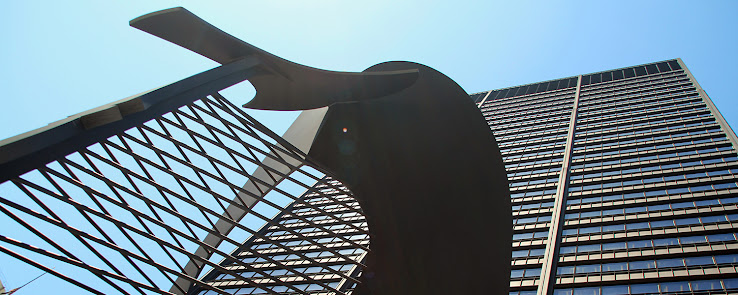
Will the Negro, in the language of Andre Malraux, find a meaning in this humiliation, make him slums, and his sweat-shops his modern cathedrals out of which will be born a new consciousness that can guide him towards freedom ?
Richard Wright's introduction
to Black Metropolis, 1945.
In the mid -to late- 19th century this part of Chicago's South Side was inhabited by waves of English, Scottish, Irish, German, and Jewish immigrants. The South Side was then the city's most prosperous quarter, and grand mansions lined Dr. Martin Luther King, Jr. Drive [originally named South Parkway, then Grand Boulevard] and nearby streets. African Americans had previously been restricted to a small area nearby, the original "Black Belt". They first began to move into this area in the late 19th century. The "Great Migration" between 1910 and 1920, spurred on by Northern industrial needs and Southern oppression, drew thousands of African Americans who primarily settled in this area because of racially restrictive housing practices elsewhere in the city.
In response to those and other racial barriers, blacks began to shape a community with its own business, social and political structure which gained national recognition as "Bronzeville", the midwest's Black Metropolis. This self-sufficient community, which became a national center of African-American economic and social life reached it's zenith in the 1920's.
The intersection of State Street and 35th Street became known as the "Black Wall Street". Prominent African American owned businesses built and occupied the Binga State Bank, Overton Hygienic Co., Douglas National Bank, and Victory Life Insurance Co. buildings. Published Robert Abbott built the Chicago Defender into one of the most influential African American newspapers in the nation, while other publications like Chicago Bee, strengthened the community's media voice.
Culturally, Bronzeville's heyday spanned through the 1940's. By night the area became incubator of the world renowned "Chicago Jazz" and "Chicago Blues" sounds. Entertainment spots such as Sunset Cafe, Grand Terrace, and the Regal and Metropolitan theaters, were home to performers like Louis Armstrong and Dinah Washington. In black churches, Thomas A. Dorsey and Mahalia Jackson were innovators in gospel music. Among the famous writers and poets associated with Bronzeville were Richard Wright and Gwendolyn Brooks.
Despite this success, the community encountered major challenges. Racial tensions continued to escalate - triggered by the drowning of Eugene Williams, a black youth who ventured into the "whites only" 29th Street beach swimming area in the summer of 1919. The riot that broke out lasted two weeks and resulted in 38 deaths.
The Great Depression devastated the economy of Bronzeville, and speculators subdivided and neglected buildings to capitalize on building shortages in the 1930's and 40's. The Ida B. Wells Homes provided better living conditions when they opened in 1938, but later public housing efforts showed how good intentions can go wrong. Urban renewal projects in the 1950s cleared what was regarded as some of the nation's worst housing, but replacement development came slowly, and the process destroyed whole segments of the community. Over the next 30 years, the spiral of decline accelerated as businesses closed and middle class families moved away.
Today, Bronzeville is experiencing a renaissance. Its historic legacy and architecture has inspired many residents to once again make the neighborhood a showcase for the best of urban life.

No comments:
Post a Comment